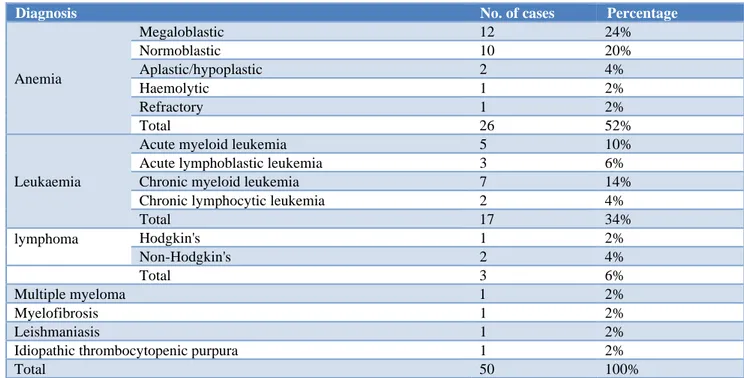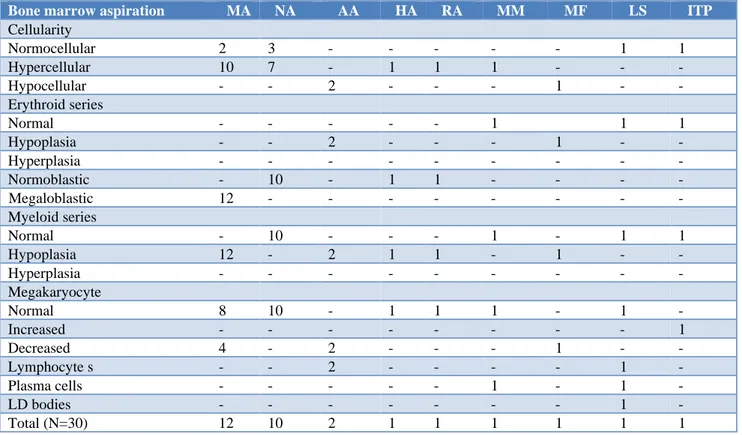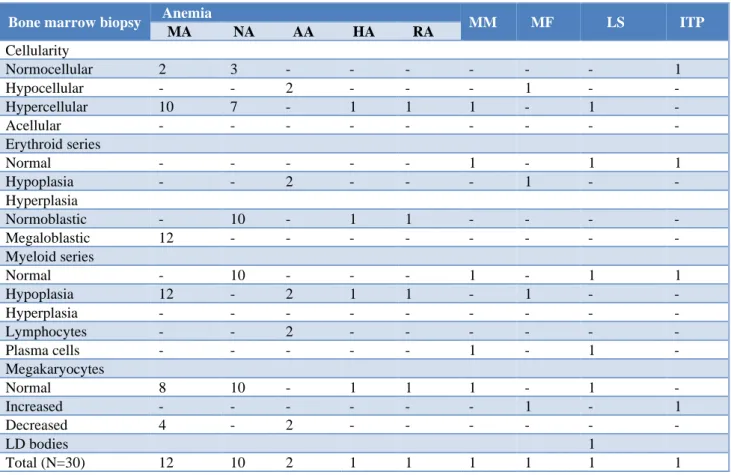Original Research Article
A comparative evaluation of bone marrow biopsy and bone marrow
aspiration in different haematological condition with special reference
to leukaemia and lymphoma
Nidhi Verma, Priya Gupta, Amod Kumar Saroj*, Preeti Singh, Veer Karuna
INTRODUCTION
Bone marrow examination is an important and effective way of diagnosing and evaluating primary hematologic and metastatic neoplasms as well as non-hematologic disorders and also for the follow up of patients undergoing chemotherapy, bone marrow transplantation,
and other forms of medical therapy.1 Many variations
exist for obtaining marrow samples (sites/ instruments/techniques). Complete evaluation of bone marrow samples should include patient history, examination, pertinent laboratory data, peripheral blood films, bone marrow aspirate smears, and biopsy imprints and sections. Bone marrow aspiration (BMA) is a simple, Department ofPathology, LLRM, Medical College Meerut, Uttar Pradesh, India
Received: 24 May 2020
Accepted: 16 June 2020
*Correspondence:
Dr. Amod Kumar Saroj, E-mail: amod.saroj@gmail.com
Copyright: © the author(s), publisher and licensee Medip Academy. This is an open-access article distributed under the terms of the Creative Commons Attribution Non-Commercial License, which permits unrestricted non-commercial use, distribution, and reproduction in any medium, provided the original work is properly cited.
ABSTRACT
Background: For diagnosis of haematological disorders there are three modalities to examine bone marrow, bone marrow aspiration cytology (BMA), bone marrow imprint (BMI) and bone marrow biopsy (BMB). BMA gives cytological picture; BMI also gives cytological picture but cells are less in number and BMB gives cytological as well as architectural picture. BMA alone may not be sufficient to reach diagnosis therefore the present study was undertaken to compare the above modalities. The study was conducted with the aim to perform cytomorphological evaluation of bone marrow in various haematological disorders with special reference to leukaemia and lymphoma and to compare bone marrow aspiration smears with bone marrow trephine biopsy.
Methods: The present study was conducted in department of pathology, LLRM Medical College, Meerut inpatients attending the outpatient department and in-patient department of pediatrics and medicine of SVBP Hospital attached to LLRM Medical College, Meerut, over a period of one year i.e. from March 2018 to May 2019. A detailed clinical history, physical examination and laboratory examination of all the cases was done.
Results: Out of 50 cases, maximum number of cases were of anemia 26/50 (52%) followed by leukemia 17/50 (34%), lymphoma 5/50 (10%), multiple myeloma 1/50 (2%), myelofibrosis 1/50 (2%), leishmaniasis 1/50 (2%) and idiopathic thrombocytopenic purpura 1/50(2%). BMA smears were compared with biopsy and concordance and discordance was established. The overall diagnostic accuracy of aspiration was 94%.
Conclusions: Bone marrow examination is a safe, quick easy and cost-effective procedure with very less patient discomfort. BMA shows better cellular details when compared to BMI and BMB. BMB is diagnostic investigation in dry tap cases like aplastic anemia, myelofibrosis, myelodysplastic syndrome and metastatic tumors. In present study, concordance between BMA and BMB was seen in majority of the cases and diagnostic accuracy was 94% study concludes that bone marrow aspiration cytology and trephine biopsy complement each other and should be performed simultaneously for complete bone marrow work up and evaluation.
Keywords: Bone marrow aspiration, Bone marrow biopsy, Leukaemia, Lymphoma
reliable and rapid method of marrow evaluation.2
Trephine biopsy provides more comprehensive information regarding the marrow cellularity, architectural patterns and overall hematopoiesis. But biopsy is a painful procedure and its processing takes at least 48-72 hours. So, to perform trephine biopsies in all patients may not be cost effective in terms of clinician and laboratory personnel time, efforts and patient discomfort.3
The study was conducted with aim to perform cytomorphological evaluation of bone marrow in various hematological disorder with special reference to leukemia and lymphoma to compare bone marrow aspiration smears and bone marrow trephine biopsy.
METHODS
The present study was prospective study consisted of 50patients of inpatient and out patients, over a period of one year i.e., from March 2018 to May 2019. A total of 50 cases presented with clinical hematological disorder, all cases were biopsied and the correlation done. The bone marrow samples were obtained from the posterior iliac spine. The aspiration needle was passed perpendicular into the cavity of the bone and 0.3-0.6 ml of marrow content was sucked with the help of a 10 ml Syringe. The trephine biopsy was performed using Jamshidi needle with the length of the biopsy core ranging from 0.8 to 1.5 cm. The biopsy was then fixed for
minimum of 24 hours in 10% buffered formalin and then decalcified overnight picric acid. The fixation of the biopsy core was followed by automated tissue processing, paraffin embedding and sectioning. All the aspirate smears were routinely stained by Jenner Giemsa while the trephine biopsy sections were stained by routine hematoxylin and eosin stain.4 All the smears and sections
were reviewed and the findings on BMA and BMB were compared and the final correlation done.
RESULTS
A total of 50 cases were subjected to BMA and BMB. Out of 50 cases, maximum number of cases were of anemia 26/50 (52%) followed by leukemia 17/50 (34%), lymphoma 5/10 (10%), multiple myeloma 1/50 (2%), myelofibrosis 1/50 (2%), leishmaniasis 1/50 (2%) and idiopathic thrombocytopenic purpura 1/50 (2%) (Table 1).
Age groups of patients varied from 1th to 7th decade. Out
of 50 cases 27/50 (54%) were female’s and 23/50 (46%) males with female to male ratio of 1.17:1. Among all the cases, maximum number of cases were found in third decade of life, 15 cases (30%), followed by 10 cases (20%) in fourth decade, 7 cases (14%) in second decade, 6 cases (12%).
Each in fifth decade and first decade and 3 cases (6%) each in sixth and seventh decade of life (Table 2).
Table 1: Final diagnosis of 50 cases of various haematological disorders.
Diagnosis No. of cases Percentage
Anemia
Megaloblastic 12 24%
Normoblastic 10 20%
Aplastic/hypoplastic 2 4%
Haemolytic 1 2%
Refractory 1 2%
Total 26 52%
Leukaemia
Acute myeloid leukemia 5 10%
Acute lymphoblastic leukemia 3 6%
Chronic myeloid leukemia 7 14%
Chronic lymphocytic leukemia 2 4%
Total 17 34%
lymphoma Hodgkin's 1 2%
Non-Hodgkin's 2 4%
Total 3 6%
Multiple myeloma 1 2%
Myelofibrosis 1 2%
Leishmaniasis 1 2%
Idiopathic thrombocytopenic purpura 1 2%
Total 50 100%
A total 19 cases of anemia showed hyper cellular marrow, 5 cases showed norm cellular while 2 case
myelofibrosis showed hypo cellular each case of LS and
ITP showed norm cellular marrow. Evaluation of erythroid series 12 cases showed megaloblastic changes 12cases showed normoblastic changes and 2 cases showed hypoplasia. Each cases of multiple myeloma LS and ITP showed normocellular and one case of
myelofibrosis showed hypoplasia. 17 cases in myeloid series showed hypoplasia while 13 cases showed normocellular marrow. 7 cases show decreased Megakaryocytes while 23 cases showed normal megakaryocytes. 4 cases showed increased lymphocytes. One case of leishmaniasis showed LD bodies (Table 3).
Table 2: Age and sex distributions of 50 cases.
Age in years Male Female Total Percentage
0-09 3 3 6 12%
10-19 1 6 7 14%
20-29 6 9 15 30%
30-39 6 4 10 20%
40-49 2 4 6 12%
50-59 2 1 3 6%
60-69 3 0 3 6%
Total 23 27 50 100%
Table 3: Bone marrow aspiration in cases other than leukaemia and lymphoma (N=30).
Bone marrow aspiration MA NA AA HA RA MM MF LS ITP
Cellularity
Normocellular 2 3 - - - 1 1
Hypercellular 10 7 - 1 1 1 - - -
Hypocellular - - 2 - - - 1 - -
Erythroid series
Normal - - - 1 1 1
Hypoplasia - - 2 - - - 1 - -
Hyperplasia - - - -
Normoblastic - 10 - 1 1 - - - -
Megaloblastic 12 - - - -
Myeloid series
Normal - 10 - - - 1 - 1 1
Hypoplasia 12 - 2 1 1 - 1 - -
Hyperplasia - - - -
Megakaryocyte
Normal 8 10 - 1 1 1 - 1 -
Increased - - - 1
Decreased 4 - 2 - - - 1 - -
Lymphocyte s - - 2 - - - - 1 -
Plasma cells - - - 1 - 1 -
LD bodies - - - 1 -
Total (N=30) 12 10 2 1 1 1 1 1 1
BMA and BMB revealed almost similar results. All 17/17 cases of leukemia and 3/3 cases of lymphoma showed hypercellular marrow. Erythroid hypoplasia was seen in all cases of leukemia while all case of lymphoma showed normal erythroid series. 5 cases of AML and 7 cases of CML showed myeloid hyperplasia while all the cases of lymphoma showed normal myeloid series. 3 cases of all and 2 cases of CLL shows increased lymphocytes. Atypical lymphoid cells were seen in all cases of
normocellular. Evaluation of erythroid series 12 cases
show megaloblastic changes 12 cases show normoblastic changes and 2 cases shows hypoplasia. Each cases of multiple myeloma LS and ITP shows normocellular and one case of myelofibrosis show hypoplasia. 17 cases in
myeloid series shows hypoplasia while 13 cases show normal. 7 cases show decreased megakaryocytes while 23 cases show normal megakaryocytes. 4 cases show increased lymphocytes. One case of leishmaniasis shows LD bodies (Table 5).
Table 4: Bone marrow aspiration/biopsy in cases of leukaemia and lymphoma (N=20).
Bone marrow aspiration Leukaemia Lymph
ALL AML CLL CML HL NHL
Cellularity
Normocellular - - - - 1 2
Hypercellular 3 5 2 7 - -
Hypocellular - - - -
Erythroid series
Normal - - - - 1 2
Hypoplasia 3 5 2 7 - -
Hyperplasia - - - -
Normoblastic - - - -
Megaloblastic - - - -
Myeloid series
Normal - - - - 1 2
Hypoplasia - - - -
Hyperplasia - 5 - 7 - -
Immature cells - - - -
Blast-myeloblast - ↑↑ - ↑ - -
Promyelocytes - ↑ - ↑ - -
Myelocytes - - - ↑↑ - -
Metamyelocytes - - - ↑↑ - -
Band forms - - - ↑↑ - -
Megakaryocytes
Normal 1 4 2 4 1 2
Increased - - - 1 - -
Decreased 2 1 2 - -
Lymphocytes ↑ - ↑↑ - - -
Plasma cell - - - -
Lymphoblast/ atypical lymphoid cells ↑↑ - - - ↑↑ ↑↑
Total (N=20) 3 5 2 7 1 2
A correlation between bone marrow aspiration and biopsy was performed in all cases and concordance and discordance was established and is summarized in Table 4. The overall diagnostic accuracy was 94% (Table 6).
DISCUSSION
BMA and BMB are important diagnostic procedures for diagnosis of hematological, non-hematological malignancies and other diseases. These procedures are also valuable for follow up of patients undergoing chemotherapy, bone marrow transplantation and other forms of medical treatment.5 BMA and BMB
complement each other. In this study, authors did a
comparative evaluation of all such BMA and BMB, to see the complementary role of both the procedures and to study the advantages and disadvantages of both the procedures one simultaneously. The spectrum of hematological disorders both in children and adults is very wide. Bone marrow examination is a useful test in reaching the final diagnosis. Bone marrow trephine biopsy is an important adjunct to aspiration in arriving at an etiological diagnosis. In present study Age groups of patients varied from 1th to 7th decade. Out of 50 cases
Table 5: Bone marrow biopsy incases other than leukemia and lymphoma (N=30).
Bone marrow biopsy Anemia MM MF LS ITP
MA NA AA HA RA
Cellularity
Normocellular 2 3 - - - 1
Hypocellular - - 2 - - - 1 - -
Hypercellular 10 7 - 1 1 1 - 1 -
Acellular - - - -
Erythroid series
Normal - - - 1 - 1 1
Hypoplasia - - 2 - - - 1 - -
Hyperplasia
Normoblastic - 10 - 1 1 - - - -
Megaloblastic 12 - - - -
Myeloid series
Normal - 10 - - - 1 - 1 1
Hypoplasia 12 - 2 1 1 - 1 - -
Hyperplasia - - - -
Lymphocytes - - 2 - - - -
Plasma cells - - - 1 - 1 -
Megakaryocytes
Normal 8 10 - 1 1 1 - 1 -
Increased - - - 1 - 1
Decreased 4 - 2 - - - -
LD bodies 1
Total (N=30) 12 10 2 1 1 1 1 1 1
Table 6: Correlation of diagnosis established on BMA and BMB.
Cases BMA+BMB (concordance) BMB (discordance) Total
Megaloblastic anemia 12 (100%) 0 12
Normoblastic 10 (100%) 0 10
Aplastic 0 2 (100%) 2
Haemolytic 1 (100%) 0 1
Refractory 1 (100%) 0 1
ALL 3 (100%) 0 3
AML 5 (100%) 0 5
CLL 2 (100%) 0 2
CML 7 (100%) 0 7
HD 1 (100%) 0 1
NHD 3 (100%) 0 3
MM 1 (100%) 0 1
MF 0 1 (100%) 1
LS 1 (100%) 0 1
ITP 1 (100%) 0 1
47/50 (94%) 3/50 (6%) 50 (100%)
The relative frequency of different hematological disorders was studied. Anemia was the commonest disorder (26/50) 54%. Amongst anemia, most common type was megaloblastic anaemia 24%. These findings are similar to a study by Gayathri et al, and Verma et al, and tilak V et al in which megaloblastic anemia was seen in
74%, 40.3%,68% respectively.7 7/50 (14%) case of
aspiration and trephine biopsy were complementary in all
the cases of malignancies diagnosed in this study. While aspiration smears were observed to be most effective for studying cellular morphology, biopsy on the other hand, was helpful in assessing marrow cellularity, pattern of involvement by leukemic cells. This study findings are comparable to the study by James et al, and Patro et al who observed that combined procedures of aspiration and biopsy gave a higher yield and are essential in patients with leukemia and lymphoma.8
There were 2 cases of NHL and one case of HL in the present study where BMB biopsy rendered information which could not be determined from aspiration such as spatial distribution and extent of infiltrates, overall cellularity and fibrosis. Present study was in accordance with Goyal S et al.9
In present study, 3 cases yielded dry tap on aspiration, which were further diagnosed by trephine biopsy. Out of these 2 cases were of aplastic anemia and 1 case of myelofibrosis. These findings are in accordance with study by Gupta et al, and Sabharwal et al.10 In which
definite diagnosis in these cases was also made by trephine biopsy. In present study, positive correlation was seen between bone marrow aspiration and biopsy. In majority of the cases and in cases where diagnosis was possible by aspiration, few cases were confirmed by bone marrow biopsy. According to Gruppo et al, Verma et al, Wintrobe et al and Nanda et al, there was good correlation between bone marrow aspiration and biopsy, and bone marrow biopsy is better in cases where diagnosis by aspiration alone was not possible.11
In present study 47/50 (94%) cases were diagnosed by aspiration while 3/50 (6%) cases were not diagnosed by aspiration which were further confirmed by biopsy. Concordance rate between bone marrow aspiration and biopsy was found to be 94%. According to Tripathy et al, the overall concordance rate between bone marrow aspiration and biopsy was found to be 62.8%.12,13
CONCLUSION
Bone marrow examination is a safe, quick easy and cost-effective procedure with very less patient discomfort. BMA shows better cellular details when compared to BMI and BMB. BMB provides information that aspiration smears fail to reveal as ground substance, blood vessels and stroma. It is the diagnostic investigation in dry tap cases like AA, IMF, MDS and metastatic tumors. In present study, concordance between BMA and BMB was seen in majority of the cases and diagnostic accuracy of was 94% study concludes that bone marrow aspiration cytology and trephine biopsy complement each other and should be performed simultaneously for complete bone marrow work up and evaluation.
Funding: No funding sources Conflict of interest: None declared
Ethical approval: The study was approved by the Institutional Ethics Committee
REFERENCES
1. Chandra S, Chandra H. Comparison of bone marrow BMA cytology, BMI cytology and BMB for bone marrow evaluation. Hematol Reports. 2011;3:e22. 2. Pandya A, Patel T, Shah N. Comparative utility of
bone marrow aspiration and bone Marrow biopsy. J Evolut Med Dent Sci. 2012;1(6):987-93.
3. Henry's Clinical Diagnosis and Management by Laboratory Methods, 22nd edition, Saunders; 2011.
4. Bain BJ. Bone marrow aspiration. J Clin Pathol. 2001;54(9):657-63.
5. Hota R, Panda KM, Bhuyan T. Clinical and histopathological correlation of ovarian tumour. Infertil. 2018;4:1-7.
6. Singh I, Jain R, Gupta GN, Goyal PK. Evaluation of bone marrow for hematological anomalies in Indian pediatric and adult patients: a single tertiary care center study. Int J Pharma Sci Res. 2015;6(4):1584. 7. Tilak V, Jain R. Pancytopenia-a clinco-hematologic
analysis of 77 cases. Indian J Pathol Microbiol. 1992;42:399-404.
8. James D, Bearden, Gary A, Ratkin, Charles AC. Comparison of the diagnostic value of bone marrow biopsy and bone marrow aspiration in neoplastic disease. J Clin Pathol. 1974;27:738-40.
9. Goyal S, Singh UR, Rusia U. Comparative evaluation of bone marrow aspirate with trephine biopsy in hematological disorders and determination of optimum trephine length in lymphoma infiltration. Mediterran J Hematol Infect Dis. 2014;6(1):e2014002.
10. Gupta V, Tripathi S, Tilak V, Bhatia BD. A study of clinico-haematological profiles of pancytopenia in children. Trop Doct. 2008;38(4):241-3.
11. Mahajan V, Kaushal V et al. A comparative study of bone marrow aspiration and bone marrow biopsy in hematological and non-hematological disorders: an institutional experience. JIACM. 2013;14(2):133-5. 12. Tripathi S, Tilak V, Bhatia BD. A study of
clinico-haematological profiles of pancytopenia in children. Trop Doct. 2008;38(4):241-3.



